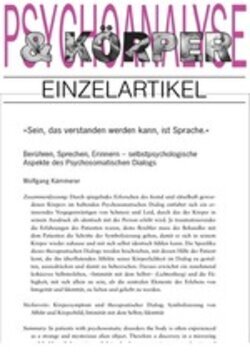18 Seiten, PDF-E-Book
Erschienen: ? ?
Bestell-Nr.: 27035
abonnieren
»Sein, das verstanden werden kann, ist Sprache.« Berühren, Sprechen, Erinnern - selbstpsychologische Aspekte des Psychosomatischen Dialogs (PDF)
Sofortdownload
Dies ist ein E-Book. Unsere E-Books sind mit einem personalisierten Wasserzeichen versehen,
jedoch frei von weiteren technischen Schutzmaßnahmen (»DRM«).
Erfahren Sie hier mehr zu den Datei-Formaten.
Durch spiegelndes Erforschen des fremd und rätselhaft gewordenen Körpers im haltenden Psychosomatischen Dialog entfaltet sich ein erinnerndes Vergegenwärtigen von Schmerz und Leid, durch das der Körper in seinem Ausdruck als identisch mit der Person erlebt wird. Je traumatisierender die Erfahrungen des Patienten waren, desto flexibler muss der Behandler mit dem Patienten die Schritte der Symbolisierung gehen, damit er sich in seinem Körper wieder zuhause und mit sich selbst identisch fühlen kann. Die Spezifika dieses therapeutischen Dialogs werden beschrieben, mit dessen Hilfe der Patient lernt, die ihn überflutenden Affekte seiner Körperlichkeit im Dialog zu gestalten, auszudrücken und damit zu beherrschen. Daraus erwächst ein zunehmend kohäsives Selbsterleben, »Intimität mit dem Selbst« (Lichtenberg) und die Fähigkeit, mit sich allein zu sein, als die zentralen Elemente des Erlebens von Integrität und Identität, zu lieben und geliebt zu werden.
Schlüsselwörter:
Körpersymptom und therapeutischer Dialog, Symbolisierung von Affekt und Körperbild, Intimität mit dem Selbst, Identität Summary: In patients with psychosomatic disorders the body is often experienced as a strange and mysterious alien object, Therefore a discovery in a mirroring and holding dialogue is needed to develop a present memory of pain and sorrow through which the body can be felt as identical to the self, The more traumatized the patient, the higher the need of a flexible step by step lead into symbolization – into a cohesive body feeling and a cohesive self identity, The specifics of this therapeutic dialogue are discussed within which the patient can learn to express and master the overflooding of body sensations and feelings, The patient develops a growing cohesive body image »intimacy with the self« (Lichtenberg) und the ability, to be alone – which are the essential elements of integrity and identity of the self perception, to love and to be loved,
Abstract:
In patients with psychosomatic disorders the body is often experienced as a strange and mysterious alien object. Therefore a discovery in a mirroring and holding dialogue is needed to develop a present memory of pain and sorrow through which the body can be felt as identical to the self. The more traumatized the patient, the higher the need of a flexible step by step lead into symbolization – into a cohesive body feeling and a cohesive self identity. The specifics of this therapeutic dialogue are discussed within which the patient can learn to express and master the overflooding of body sensations and feelings. The patient develops a growing cohesive body image »intimacy with the self« (Lichtenberg) und the ability, to be alone – which are the essential elements of integrity and identity of the self perception, to love and to be loved.
Keywords:
Psychosomatic symptom and therapeutic dialogue, symbolization of affects and body image, intimacy with the self, identity
Psychoanalyse & Körper, Nr. 9 (2006), 5-22Doris LangeS. 23–38Selbstfürsorglichkeit. Die körperpsychotherapeutische Behandlung des »frühen Mangels« mit der Methode der Funktionellen Entspannung (PDF)
Psychoanalyse & Körper, Nr. 9 (2006), 23-38Godehard Stadtmüller & Jeffrey A. Gordon S. 39–65Biologische Korrelate von Emotionen (PDF)
Psychoanalyse & Körper, Nr. 9 (2006), 39-65Peter GeißlerS. 67–87Videomikroanalyse der frühen Interaktion: ein wissenschaftliches Instrument auf dem Weg zu einer modernen körperpsychotherapeutischen Theoriebildung (PDF)
Psychoanalyse & Körper, Nr. 9 (2006), 67-87
»Mein Fazit lautet, dass es sich beim besprochenen Buch um ein lehrreiches Konvolut handelt, von dessen Lektüre man eigentlich nur profitieren kann. Die eingehende Beschäftigung mit dem Sujet kann Psychoanalytikern wie Psychotherapeuten helfen, den Blick für die nonverbale Komponente des therapeutischen Prozesses zu schärfen, die man sonst vielleicht unter dem Eindruck der Flut von Worten untergehen lässt. Positiv hervorzuheben ist für mich noch, dass das Buch auch repräsentativ für eine moderne und offene Psychoanalyse ist, die weder den interdisziplinären Dialog noch die empirische Forschung scheut ...«
Gerald Poscheschnik, Psychotherapie Forum Vol14 No.2/2006

